From the book "Straight to the South", part 3 "Visiting a sea cow", episode 17.
| 18.03.2018 |
Andamans and Nicobars are the meeting place of Eurasia with India and Australia. Meridional elongated chain of fragments of land was appeared at the junction of the global lithospheric plates, separating the two basins – the Bay of Bengal in the West and the Andaman sea in the East. The result of lapping three platforms to each other - tectonic scales, partially or completely melted, they are a crystal base for the local islands. The process began only 38 million years ago (compared to the age of the Earth - more than 4.5 billion years - it is like yesterday) and still lasts. There are frequent earthquakes there, carrying with them the devastating tsunami waves, and there are active volcanoes sticking out of the sea, spewing lava nozzles, on the Eastern flank of the island system. It is restless, in general.
In my article about Sri Lanka, I wrote that the first settlers there were immigrants from Africa, who migrated to the East in ancient times. On the Andamans, this theory is confirmed: initially the islands were inhabited by ancient African colonizers of Asia. They are called "negrito", spanish for "little blacks", it is a generalized designation of people Negresco type of the Melanesian race, Asian and Australian pygmies. It is believed that they have a unique innate ability to biolocation - they can to determine where any animal locates at a considerable distance, like a radar. Their growth below 150 cm, the skin is very dark.
Black little men have been known since the Roman Empire, but they had a bad reputation. Marco Polo, for example, called them cannibals with a dog face. However, researchers of the early XX century left the following records: "This is a loyal and gentle married couples, they are not cannibals, they do not hide in earthen burrows, like rabbits, they do not roast pigs in tree hollows. They believe that Peluga lives in the sky - an invisible creature that lives in a stone house. This deity has created everything except evil spirits, whose power cannot be resisted."
The fate of the four tribes known in the Anamans is sad: they lived at the level of the stone age, they suffered from viruses brought by foreigners, to which they had no immunity, were exterminated by English colonizers, they died in the waves of a giant tsunami, but continued to persist in preserving their world, resolutely and aggressively protecting it from aliens.

Today, the remains of these tribes live in the forests far from civilization of the Sentinel Islands, part of the archipelago, and they do not intersect with the prevailing here newcomers from India. As for thousands of years, these people (still living in the Paleolithic age) stop any attempts at contact, killing uninvited guests with bows and arrows, and the government of India has decided to guarantee their isolation, setting an absolute ban on visiting this lost world, hidden on 60 square kilometers of land. In General, our disappointment #1: we will not see wild tribes.
Well – let's talk about everything in order: from the city of Chennai (it called Madras up to 1996) early in the morning we flight by Air India and aarived to the capital and the largest settlement of the Union territory of the Andaman and Nicobar Islands – the city of Port Blair. This day we had to get to the island of Havelock to start our diving program.
The communication between the Andaman Islands is carried out by ferries, to buy tickets for which in advance is very problematic: the payment by credit card on the website of the ferry company has not passed, which is a common thing for India, and it could be no ticket at the box office on the day of your arriving. After a long correspondence, we were able to get an agreement with a small local travel agency to transfer them money for tickets for a private ferry "Makruzz" and half a day excursion on Port Blair - departure after lunch, and we have half a day somewhere to wait, so why not in a car with air conditioning, looking at landmarks at the same time.
They pick us up, half-asleep, into the car and drove somewhere along the coast out of town. It turned out - to the beach. In General, Port Blair is not a beach place, but there is one called Corbyn's Cove Beach. It is muddy, cows graze near the shore. But a lot of the sand, and you can splash in the sea or ride on hydrocycle.
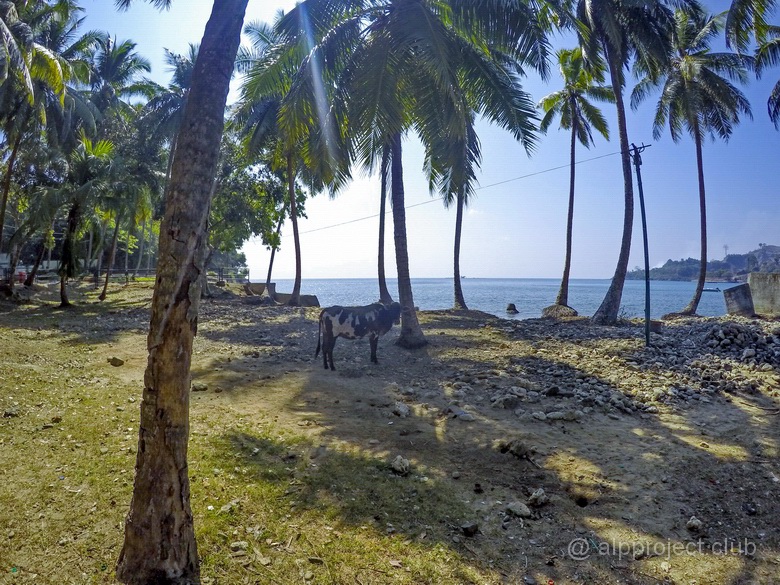
At weekends and in the evening, they say, it was crowded here, but in the morning there is almost no one here. A tiny restaurant already worked, where coffee was served. The recipe for its preparation is special here, the boy poured something, mixed and conjured a little while, whispering something. The drink was delicious and, most importantly, on time, we just needed a little brain refresh after a sleepless night.
Then we walked about 15 minutes, looking at local attractions. The beach is convenient for landing from the sea, there are still concrete pillboxes built by the Japanese during the World War II, that did not fulfill their purpose - the positions were conceded without a fight after the total surrender of Japan. In addition, you can still find traces of the great tsunami of 2004 here – sawn coastal row of palm trees and some not fully restored beach buildings.
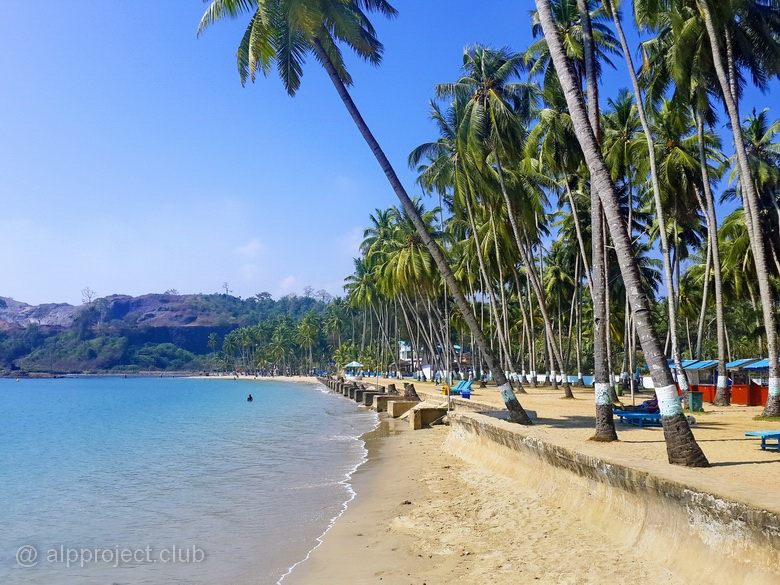
Corbyn’s Cove Beach
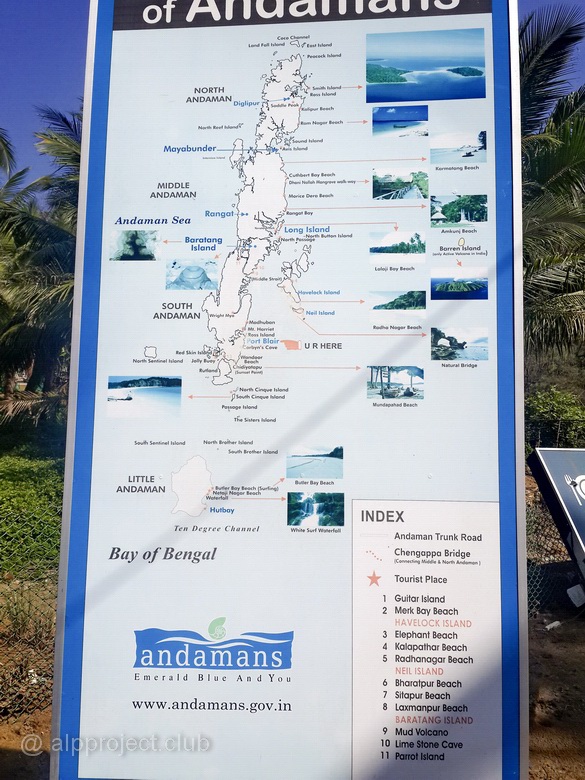
Map of Andaman and Nicobar Islands - information board on the beach

Park near the "Cellular jail"
The next point of the excursion program was the infamous "Cellular jail". It was built at the begining of the twentieth century. It contained members of the anti-British uprisings.
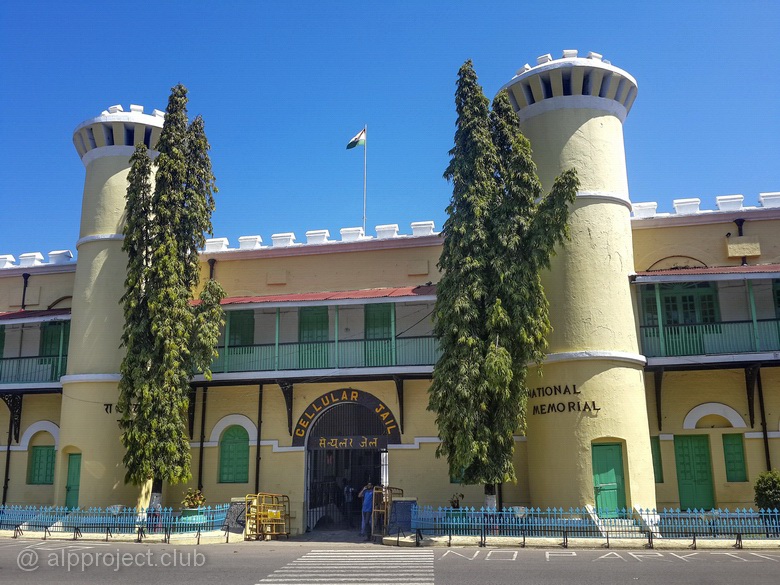
Patriots who raised their voices against colonial rule were coming here from all over India. The building itself is a ridiculous structure, two wings of which form a triangular courtyard, covered with a lattice canopy.

Up to two thousand prisoners, doomed to slave labor, were kept in the cells at the same time. Long ago there was a press for oil, which was rotated not by oxen, but by people. The prisoners fainted ten times a day from fatigue, but the guards brought their wards to their senses and forced them to work again.


Not only this prison – the whole of Port Blair and the surrounding islands in those days were place for penal servitude. The barracks housed several thousand prisoners engaged in hard labor, which wasn't stoped because scorching evil sun, nor tropical torment rains, and many, unable to endure torture, ended their lives by suicide…
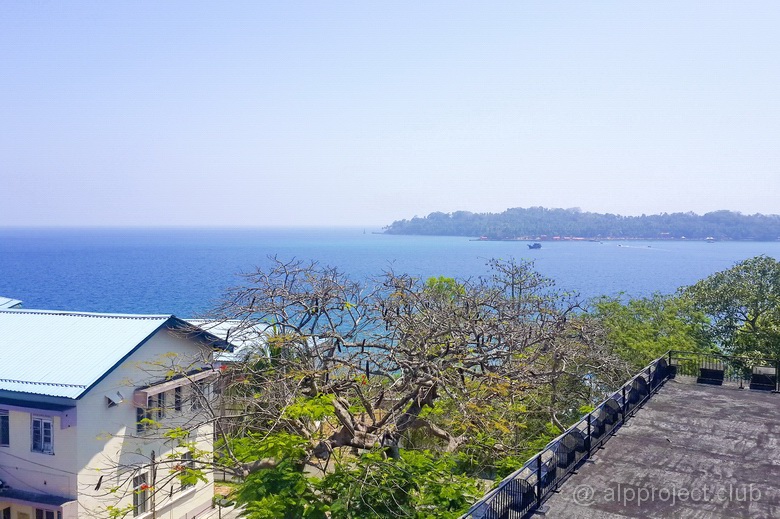
View from the roof of the jail to the island-penal Ross
The life of the prisoners was a kind of hell. Hundreds of them died from fever, tropical diseases and excessive work, died from well-aimed arrows of natives. Escape was futile: on the one hand – the endless sea on the other – impenetrable forest, infested with poisonous creatures.






There were many prominent freedom fighters here, the most famous of whom was Vinayak Damodar Savarkar – a politician, revolutionary, poet, writer and playwright. He is the author of the Hindu nationalist ideology of Hindutva. He advocated the abolition of the caste system and the conversion indians who converted to Islam and Christianity back to Hinduism. He lived more than eighty years, died in 1966, was one of the eight defendants in the case of the murder of Mahatma Gandhi and the only one who was fully acquitted. In India he is revered, Port Blair airport is named after him.
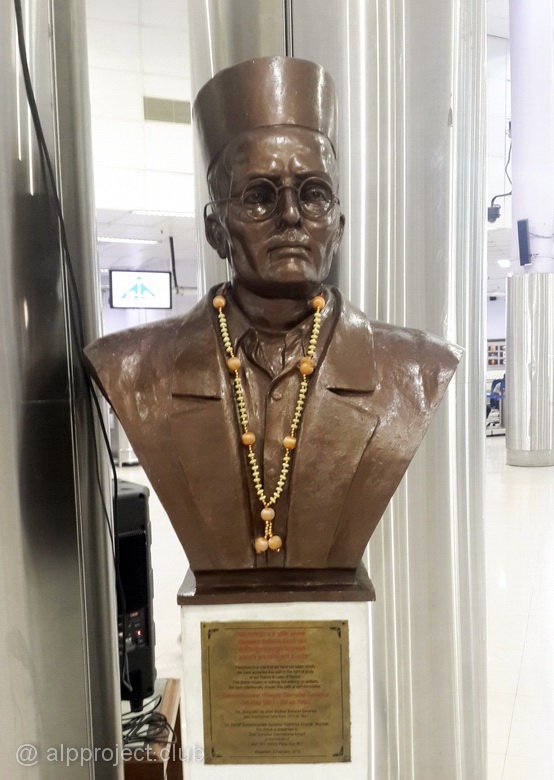
Vinayak Damodar Savarkar – bust in the airport

Monuments to prisoners near the prison entrance
"Cellular jail" today has become a symbol, rallying the Indian people under the flag of the idea of national independence.

The last pray place before the execution

Everlasting fire
Tourists from all over India awe inspect the evidence of struggle era, listening to the stories of guides and disapprovingly glancing at us, white people, wandered into this temple. But when they found out who we are, their faces blurred in smiles: the slogan of the Soviet-Indian friendship "Hindi rusi bhai bhai!" is not forgotten here :) In General, the attitude of the Indians to us everywhere was the most benevolent, they communicated willingly and with interest and they were always ready to help guests.

Political demonstration at the entrance to the prison
We refused visit the anthropological Museum, we were too sleepy, we decided to read about it on the Internet later. Instead, we asked to be taken to a nice fish restaurant – it was time for lunch. There were not the cheapest prices there, we refused expensive lobsters and allowed ourselves to eat crab and snapper cooked with seasonings, how could you avoid of fresh seafood near the sea.
A short movie about the day we spent in Port Blair:
Then the time came to drive to the pier. Sea ferry "Makruzz" - high-speed catamaran, a ship with a double hull.
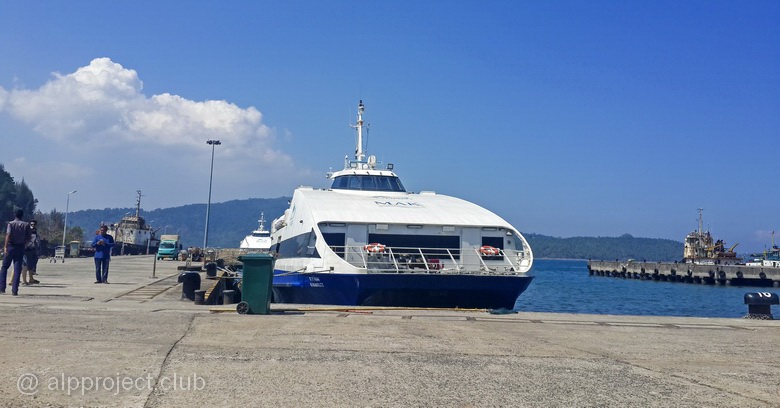
It has two decks, capacity 280 passengers, cabins are divided into 3 classes, the difference in the price of which is quite significant, but it makes no sense to choose "Deluxe" or "Royal" – the same seats, only rooms for the privileged persons have smaller size. The ship is sailing at a speed of 22-24 nautical miles per hour, travel time is one and a half hours. You can admire the sea only through the window with blue glass – it is prohibited to exit from the salons outside. The only entertainment is a large screen in the center of the cabin, where the hits of the Indian pop music are played, and a small bar where you can buy a bottle of Cola and some snack. AC runs - cool enough, the seats are not tight, and if you doze – the road will not notice.
And here we go to the pier of Havelock island. They meet us – nice! Our friend Olga arrived here the day before, already settled and very happy to see us. Tuk-tuk for 100 rupees, 10 minutes after we are in the hotel "Sea Shell Havelock". But that's another story...
< episode 16 |
episode 18 > |


